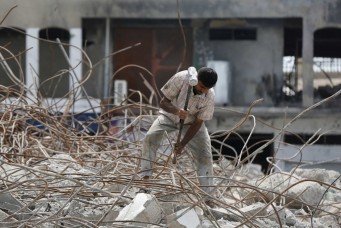Behind Iraq’s Crony State
ISIS and other militants dominate the headlines, but Iraq’s citizens face daily another, equally terrifying threat: a failing, and criminally corrupt, state.

Protesters shout slogans against corruption, Tahrir Square, Baghdad, Aug. 7, 2015. Thaier Al-Sudani/Reuters/Corbis
A year after his appointment Iraqi Prime Minister Haidar Al-Abadi continues to face an uphill struggle to build a politically inclusive and functionally viable state. His success in pushing an ambitious reform plan through parliament on August 11, 2015 was an important step forward, but is running into increasingly stubborn resistance from the very parliament that originally approved it.
The reform plan will moreover prove inadequate without genuine political backing from the most powerful domestic and external actors involved in Iraq. These, however, remain focused almost exclusively on militarily defeating the Islamic State in Iraq and Syria (ISIS), and are not invested in effecting meaningful political reconciliation between the country’s Sunni and Shiite Arab citizens, fully pursuing structural military and financial reforms, and ensuring the equitable delivery of crucial social services.
As a result, the Iraqi state may have passed the point of no return.
While the domestic and international focus on the military effort against ISIS has highlighted the severe flaws of the Iraqi army and security sector, it has further obscured the failure of the Iraqi state to provide social services, economic development and diversification, and their associated infrastructure and legal and regulatory frameworks. As a result Iraq, which has the world’s third-largest proven oil reserves, also has some of the worst socio-economic indicators of the region and is well below the average for similar upper-middle-income countries.
But most seriously, a self-serving political class and dysfunctional governing system have failed Iraqi citizens by creating conditions for distorted development; deep structural poverty (now affecting 30 percent of the population) and unemployment; and widening gender, generational, class and regional disparities.
These failings reflect the emergence of a crony state in Iraq over the past decade. Prior to his downfall in 2003, Saddam Hussein had emphasized technocratic competence and kept corruption to a minimum within the government apparatus, extending the state’s bureaucratic reach as a means of universalizing patronage while centralizing it in his own hands.
In contrast, crony transformation was driven after 2003 by the “democratization” of patronage—as multiple political factions competed for cabinet posts from which to establish rival power bases within the bureaucratic apparatus and security sector—and the increasingly overt sectarian nature of politics, especially under former Prime Minister Nouri Al-Maliki, which made it easier for competing factions to “capture” and defend their gains, and to mobilize their constituencies against rival attempts at or demands for accountability.
In 2014 Transparency International ranked Iraq as the 170th most corrupt out of 175 countries it monitored worldwide. Clientilistic public sector employment and systemic corruption have resulted in the severe shrinking of public investment in critical infrastructure; the crowding out of the private sector; the decline of non-oil productive sectors, especially agriculture; the blunting of job growth and increasing dependency on the state; the generation of an outward brain drain and a human capital deficit at home; and the exclusion of parts of the country from the development process. It is doubtful that the reform plan of August 2015 can dislodge a rentier system that is so pervasive, even if the initial measures undertaken by Abadi are not rolled back.
Iraq’s extensive crony system is threatened by the loss of $40 billion in state revenue in 2015 due to the precipitous drop in global oil prices, imposing a projected deficit of $25 billion on the state budget (25 percent). Dependent on oil exports for more than 95 percent of public revenue and 80 percent of foreign exchange earnings, and faced with the prospect of depressed prices for several years, the government has been compelled to seek International Monetary Fund loans and World Bank development grants. This is besides the cost of assisting the eight million people estimated by the United Nations to be in need of humanitarian assistance in Iraq: 2.9 million of them have been displaced since 2014, and the overall figure is projected to reach 9.9 million by the end of 2015, or nearly 30 percent of the Iraqi population.
The Abadi government must start showing visible successes where its predecessors since 2003 have failed in making a head start on rebuilding a viable state and crafting a new social pact, even as it faces the existential threat posed by ISIS. The August 2015 reform plan is a start, but must be swiftly deepened and widened, or risk utter defeat. The United States, Iran, and other external powers must also throw their weight behind it—unlikely as such convergence is—if the Iraqi state is to start looking and acting more like a state. But even if the state is not broken beyond repair, the domestic and external actors most committed to its revival may not have enough political and financial capital to fix it.
This article is an excerpt from a report published by the Norwegian Peacebuilding Initiative Centre.
Yezid Sayigh is a senior associate at the Carnegie Middle East Center in Beirut.



